
RIDE IMPRESSIONS
Forge+Bond Wheels
At my level of involvement in the bicycle industry, I am seldom functioning with complete information. I come at things with an interesting level of blissful ignorance in a sea of passionate knowledge. This particular story follows that pattern.
It starts with a conversation with Pete, where he gives me half of the information, most of it incorrect. The “wheels” portion of things was all good. So was the “new brand from CSS”. The dates were mostly correct, as was the state where things were taking place. Beyond that, I was flying blind.
From there, a few more e-mails were exchanged and a box showed up at my door. I opened it up and found a nice looking pair of carbon wheels. Then, a few days later I hopped in my vehicle, drove down to Bellingham and found out what the hell was going on.

I actually kind of dig that it looks like I might fall asleep in this photo.
Forge+Bond
The name is Forge+Bond, and there’s a deeper backstory than you would imagine as to what that name means and where it came from. But, this is North Shore Mountain Biking, not North Shore Marketing Aficionado, so let’s not worry too much about the mission statement, brand experience, identity and message. What I took away is that Forge+Bond is the house brand from the company (that is CSS) that has brought you Fusionfiber wheels from Revel, Evil, Chris King and a few others.
The focus of that company is carbon fiber reinforced thermoplastic (I’m going to call it “thermoplastic carbon fiber” or “thermoplastic” from here. I haven’t made up my mind yet). We’ve heard a few times over the years about the wonders of thermoplastic carbon fiber over the traditional thermosets with which we are more familiar. I’ve got to admit that upon reading that pitch, I was a bit skeptical: “Fully recyclable”, “Less energy use”, “Automated and Made in the USA”. On the surface, these all feel like really good things, but we’ve been burned so many times by the bike industry blowing smoke up our asses, it becomes hard to take things at face value. It seemed like a good idea to meet some of the Forge+Bond crew and talk about these things in person.

What do the actual wheels look like? Well, here they are in front of a waterfall.
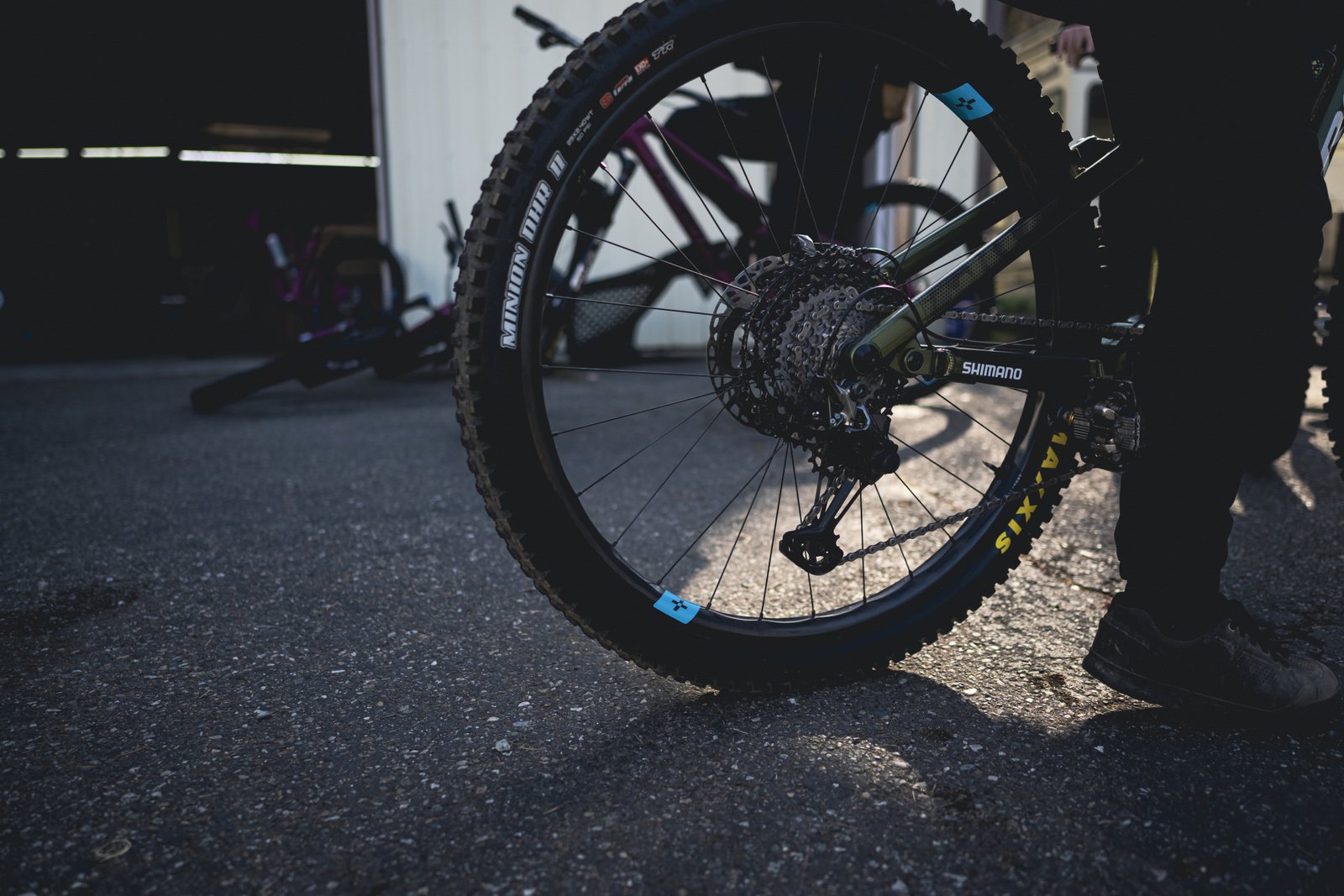
Here's one mounted to a bike.
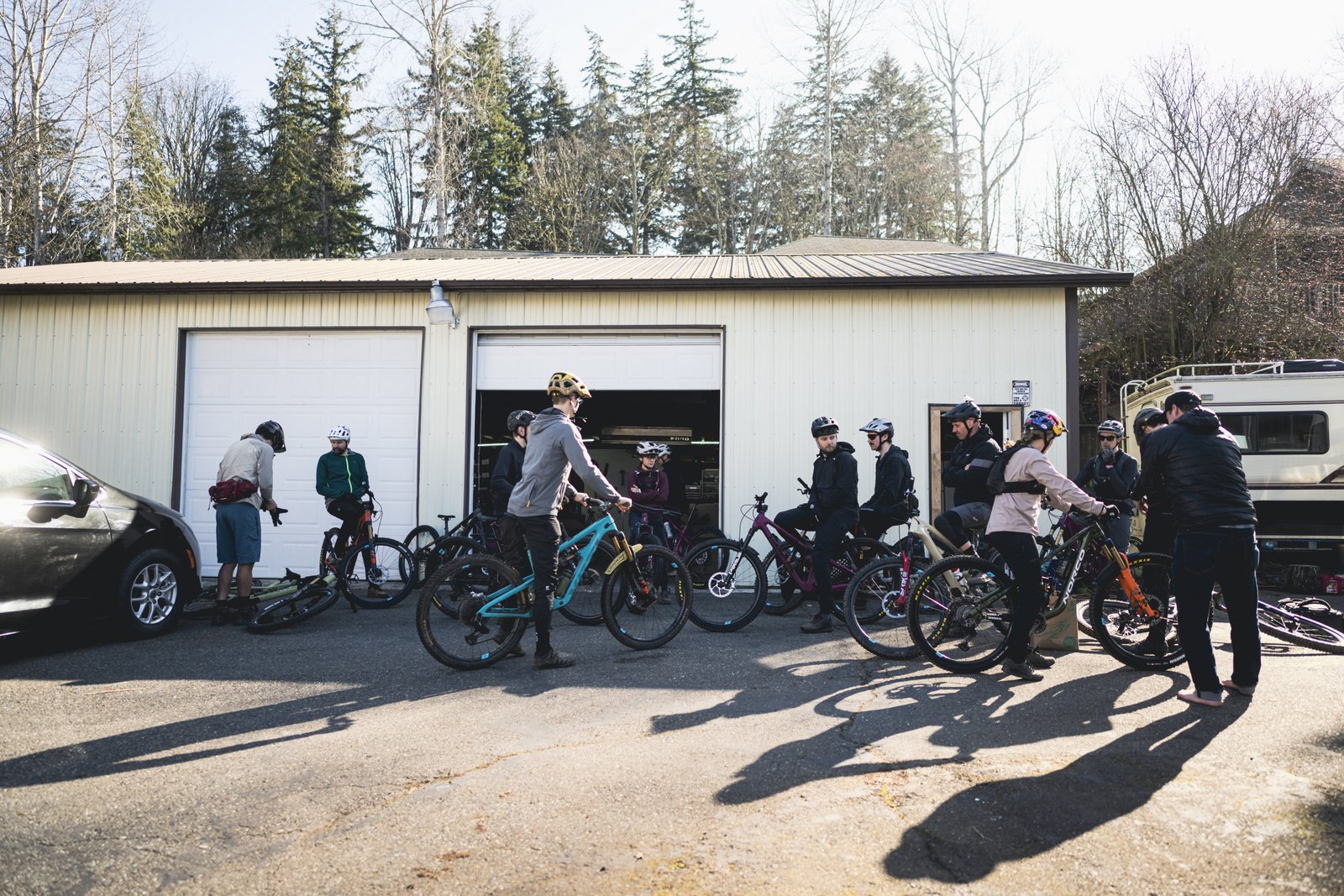
And here's an exciting behind the scenes shot of an industry ride.
Recyclability
Some of you will remember the recycling manifesto that I posted a month or two back. It was long and it was judgemental. It talked about lofty goals like manufacturers taking responsibility for their products from start to finish, and owning what they create from the cradle to the grave. Colour me shocked to hear the Forge+Bond crew using similar terminology. Unprompted!
That article also hinted at the challenges of carbon fiber and the lack of recycling options available for these products. Yes, we have heard the pitch for thermoplastics as “fully recyclable”, but this always felt like a bit of a far-out-there pipe dream. Where exactly am I going to take my fully recyclable bicycle frame for recycling once I’m done with it?
I see now that my thinking on this was a bit limited. We tend only to consider things as they are for us, not as they could be. Recycling is dropping a dozen beer cans in our blue bin after a long night of sadness and regret, for example. The system we’ve created is one of making something, buying something and then handing it over to somebody else to take care of it. When we talk about “recyclability” and carbon fiber, it isn’t really that.
For CSS and Fusionfiber, it starts in the factory. First and foremost, they claim to be a nearly zero waste facility. They’re taking all of their cutting room scraps and seconds and screw-ups, and they’re turning it into something else. This is sort of like a machine shop collecting all of their metal shavings, melting it down in the corner and turning it into a new billet. I’m not aware of too many other manufacturers turning their scraps into something else over in another corner of the building. Their goal is to bring every end-of-life rim back to the factory to get turned into something else once you’re done with it. The conversation starts with how that is possible.

Obligatory sitting-next-to-Jill-Kintner-while-listening-to-somebody-talk-about-wheels photo. They actually cycled us all through so we could each get this photo. We each moved one position to the left as Paris re-framed. No, not really.
Fusionfiber
Let’s all assume we have a rudimentary understanding of what goes into making a carbon fiber bike part. I don’t know if this is the industry standard way of making a wheel, but there are enough similar-looking videos for you to gain some understanding of how your thermoset carbon fiber rim is made. There are obviously different levels of refinement, but chances are good the typical wheel is some form of carbon fiber pre-preg “fabric” is laid up in a mold, the mold is cooked under heat and pressure, and out the back end spits your rim.
Unfortunately, many of the conversations with Forge+Bond ended with “if only you could see it, you’d totally understand!” or “it’s so cool, we just can’t show you!” At this point, fully buying into the Forge+Bond program requires a bit of suspension of disbelief, but the nuts and bolts are:
- The fibers are largely the same as what you’d get in many other thermoset carbon fibers.
- The matrix is the difference. Where a thermoset uses some form of epoxy, the Forge+Bond thermoplastic uses a form of nylon.
- Fusionfiber is the proprietary use of standard, off-the-shelf thermoplastic material. What’s proprietary is how it’s put together, and the specific combination of heat, time and pressure – Forge+Bond advised that their patent was a good place to start if you really wanted to understand things. I tried but didn’t get very far.
- The cost of entry into thermoplastic is higher than that of thermosets as it requires a certain amount of automation.
What Forge+Bond claims to have is a competitive advantage over other wheels, partially down to the material itself, and partially down to how they work with it. So understanding their product requires a bit of understanding of these two things.
As mentioned above, a typical thermoset rim is laid up and cured in a one-step process. The epoxy holding it all together hardens through a chemical reaction. There’s no re-forming once your product is set, and you need to burn or chemically strip away the matrix if you wish to recycle the fibers.
With thermoplastic carbon fiber, there’s no irreversible chemical reaction taking place during curing. Instead, the material is heated up to a high temperature and more-or-less melts into the shape of the mold. This property allows you to form it, and re-form it again. To recycle it, there is no need to strip away the matrix, you can just chip up the material, put that in a mold, cook it up and Bob’s your uncle.
Of course, it’s a bit more complicated than that. By chipping the material up, you’re left with a bunch of short little fibers, far from ideal for turning into another rim. But for other parts, this material is more than okay. CSS has even gone so far as to create a sister company to start to turn this material into other useful products. More projects are hinted at, but for now, the sole cycling-related product is a tire lever. A thermoplastic carbon fiber tire lever might sound like a bit of a joke, but after breaking several cheap plastic levers over the weekend trying to get a DH tire onto a rim, I’m not so sure that it is. The finished lever has all the properties you want from a plastic lever (light and non-marking) with all of those you’d want in a metal lever (strong as all hell and stiff as a board). Holding that thing in my hand it felt like it wouldn’t even think of bending and I had dreams about what I would do with those bad boys if they were in my possession.
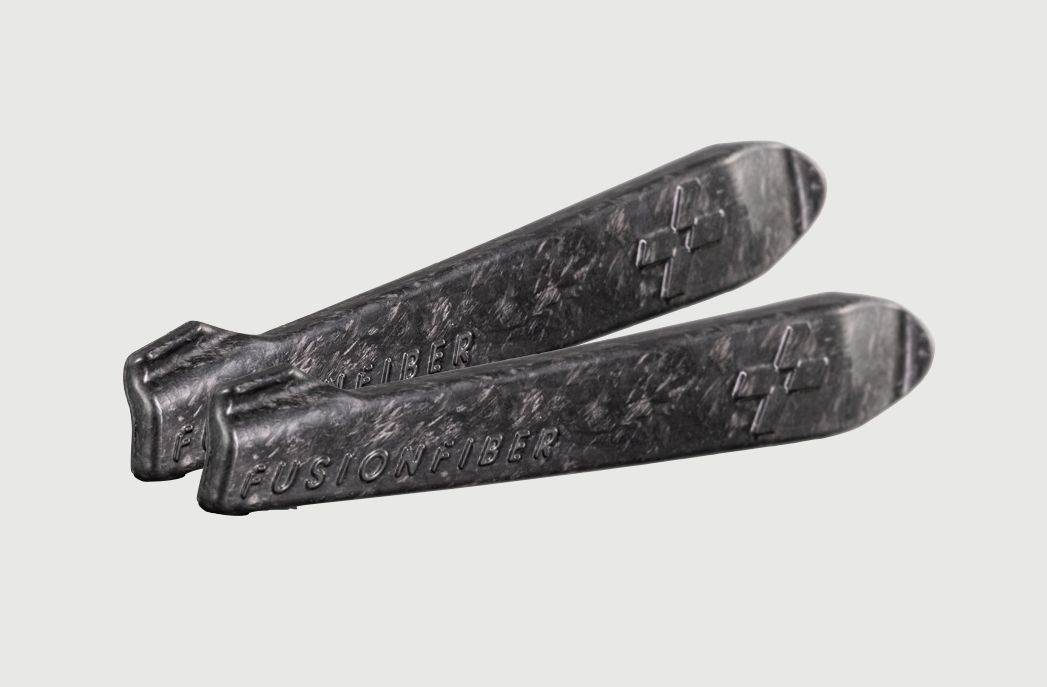
The fanciest tire lever you'll probably ever lay your hands on.
Manufacturing
Beyond ease of recycling, thermoplastic carbon fiber has other differences. A major one is that the material in its raw form is different than that of a thermoset. Again, without seeing how this works, it’s hard to imagine what is going on, but what I understood is that at room temperature thermoplastics are not as pliable as thermosets, and require a fair amount of heat before they can become workable. Hand-laying soft fabric into a mold isn’t an option. New ways of manufacturing a wheel are required.
The way I think of it is manufacturing by sub-assembly, rather than a one-step process. A Forge+Bond wheel comes together as three large pieces. You have each sidewall, and the center rim bed formed as a separate piece before being brought together as a wheel. The final assembly of the wheel is probably the closest approximation to building a thermoset wheel (according to Forge+Bond, of course…but they alluded to a mold and a bladder). The three pieces fuse together (or “bond”, as it were) under heat and pressure, no additional glues or resins are required. The largest difference is how you construct those three pieces. Forge+Bond likened the making of each of those pieces to stamping or (wait for it) forging (aha!). They claim greater compaction due to this process. And you can sort of see it. Stamping out a relatively flat piece of carbon fiber is going to be easier than forming a complex 3-dimensional structure. Time will tell if this makes a better wheel.
Forge+Bond also claims that thermoplastics are a better riding material, not just a better manufacturing material. Again, I don’t have any details but the suggestion is that the material properties of the matrix add a degree of vibration damping and flexibility to their rim. They also point out that their material has no expiration date and doesn’t require refrigerated storage, further eliminating waste and energy consumption in manufacturing.
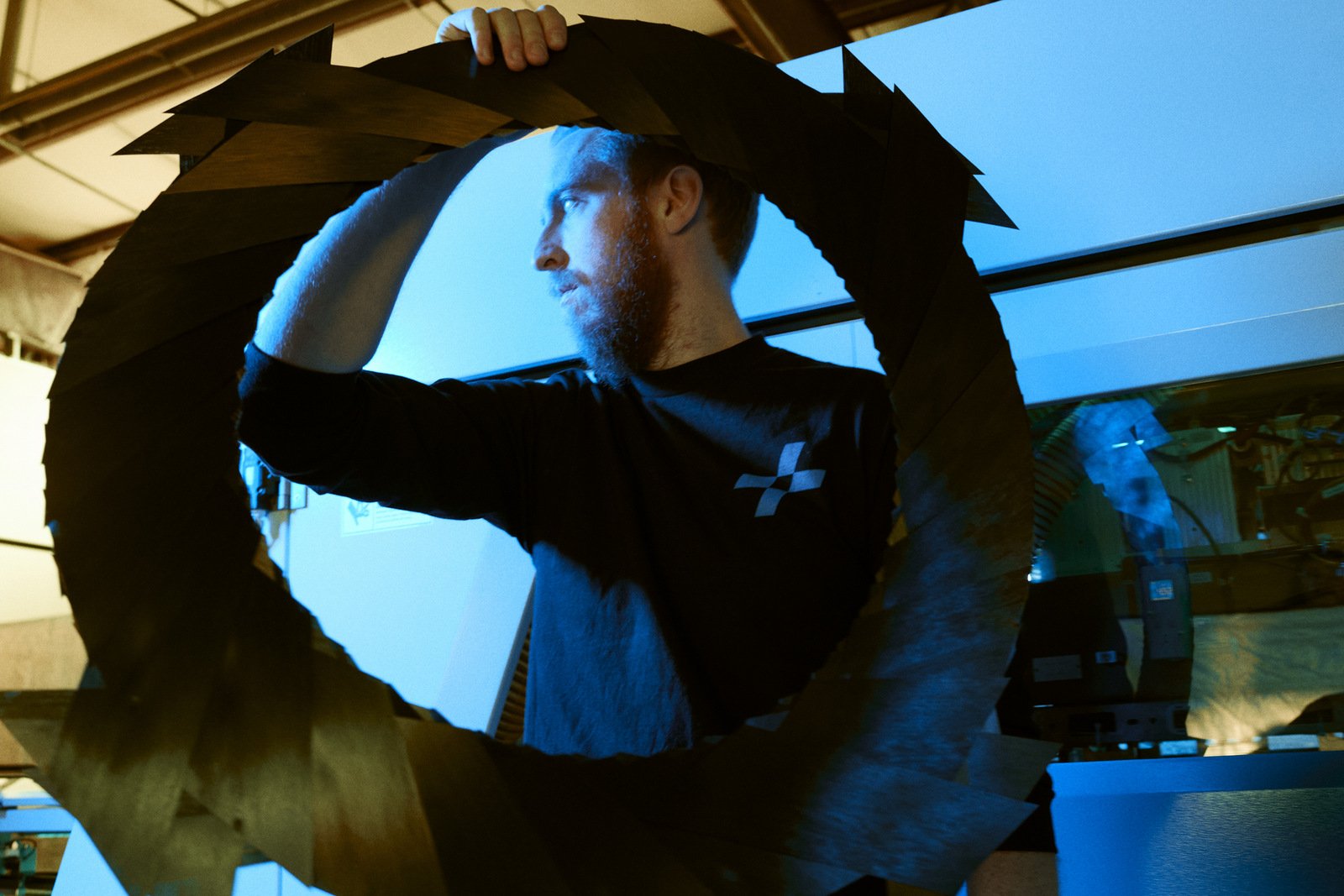
I sifted through the press materials to find some images of manufacturing. Forge+Bond calls this "radial cross-ply" and it hints at the process. You can see how the sidewall layup starts as a flat piece before being pressed into shape.
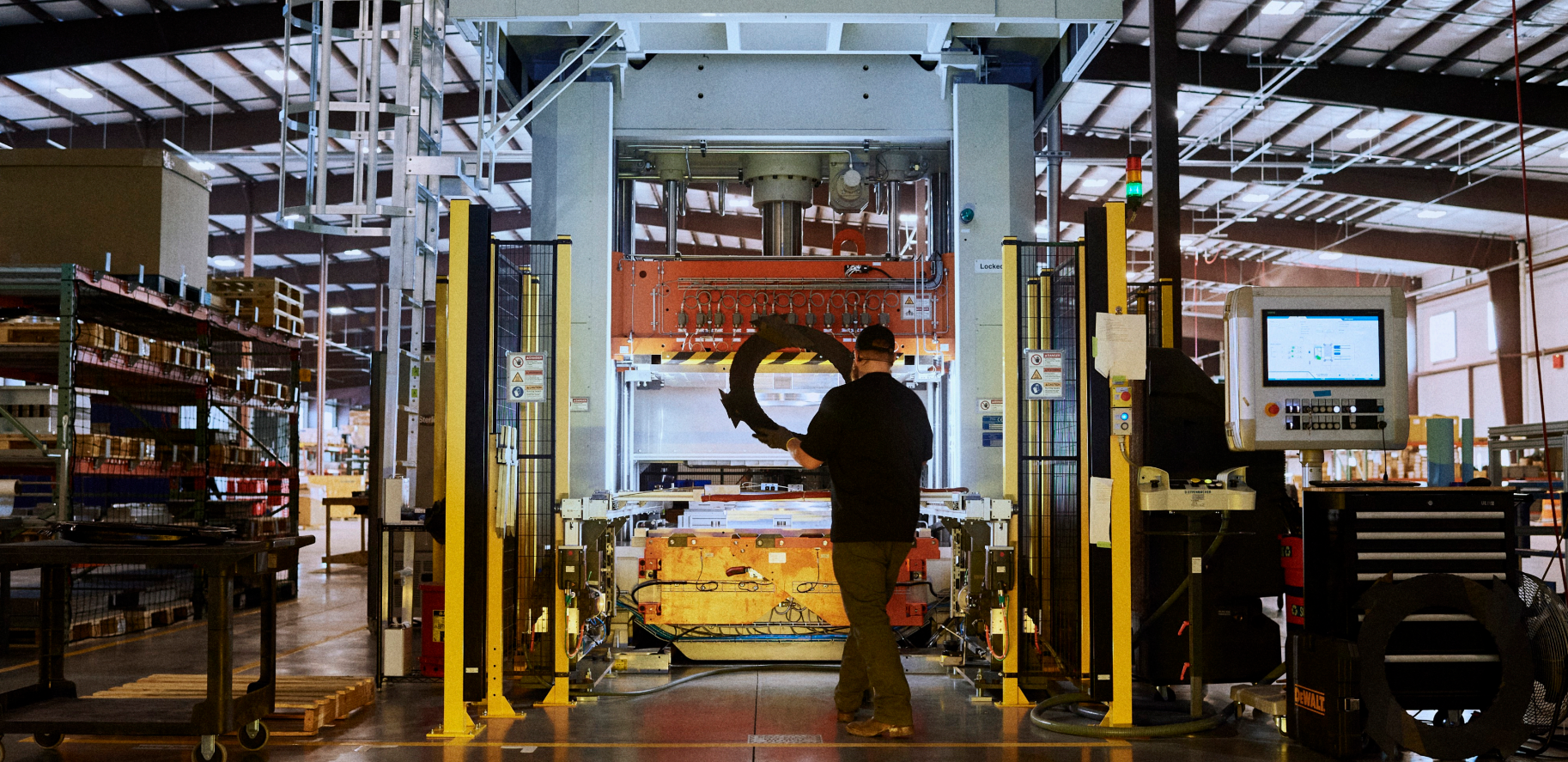
I assume this is the big machine that does the pressing.
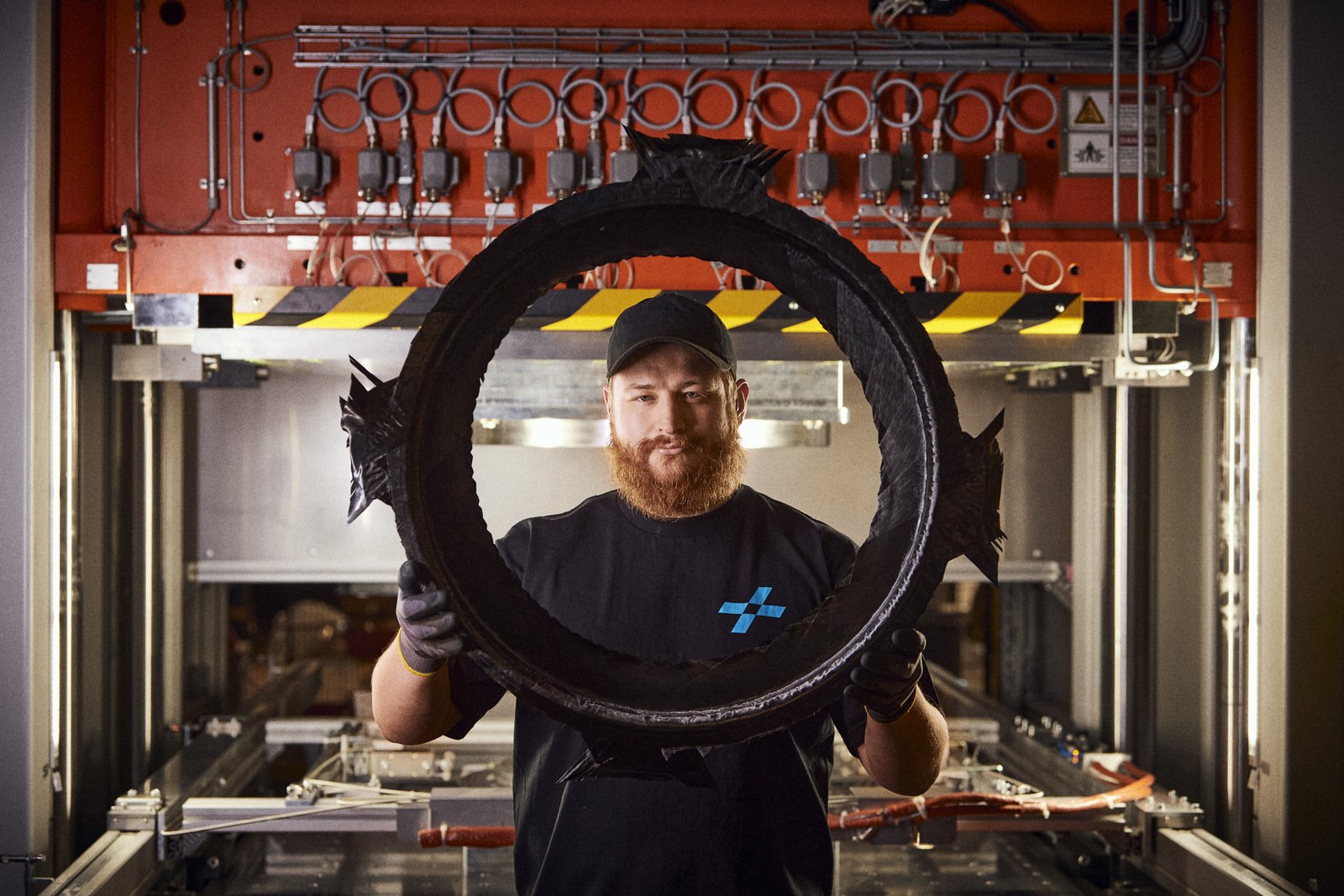
And out of the mold. Hard to say what happens from here. Does that excess material remain intact and wrap around other parts? Or not?
The Wheel itself
So that’s how they make it and what they make it with. What about the wheel itself? Well, what you have here is the Forge+Bond "30 EM 29” wheel. They’re suggesting this is perfect for “enduro and aggressive trail riders”. The goal was strength and performance, not necessarily light weight.
The rim itself is constructed with Forge+Bonds “NXS” technology. This refers to the facets that you see on the rim and places more material where you need it (at the spoke hole) and less where you don’t. This seems to be one of the primary differentiators between the Forge+Bond rim and the ones they are making for third parties.
Ignoring the rim, the wheel starts with Industry Nine Hydra hubs, 28 holes front and rear (32 hole is available). It uses Sapim D-Light spokes and mates with the rim to create a (by my measurement) 886-gram front wheel and a 1,058-gram rear wheel (incl. rim strip and valve). From this, there are a few things to note:
- Hubs – pretty standard stuff. Forge+Bond indicates more options to come but wanted something solid and predictable to launch with - more options will follow.
- 28 spokes is a number I’m not used to seeing in a rear wheel.
- 2.0/1.65/2.0 Sapim D-Light spokes are on the lighter side of things, as well.
- Dimensions are given as 38mm external and 30mm internal, for a recommended tire range of 2.3” to 2.6”.
- MSRP is 2,599 USD.
- There’s also a gravel wheel available now, and additional models of mountain bike wheels are on the way soon.
- Right now, you can buy direct from Forge+Bond in Canada and the US, with dealer and distributor arrangements worldwide coming in the near future.
Above, we mentioned warranty as the means Forge+Bond is using to reclaim material. One would expect that it would need to be a fairly thorough warranty in order to entice people to ship their broken wheels back to the factory. And it seems like it is! There’s a lifetime warranty on defects in material and workmanship, as well as a secondary warranty to cover ride-related breakages (which, if I’m reading it correctly is the same as the defect warranty but just requires you to pick up the tab on shipping). Secondary owners are even covered under the crash replacement program and will receive a discount on a new rim.
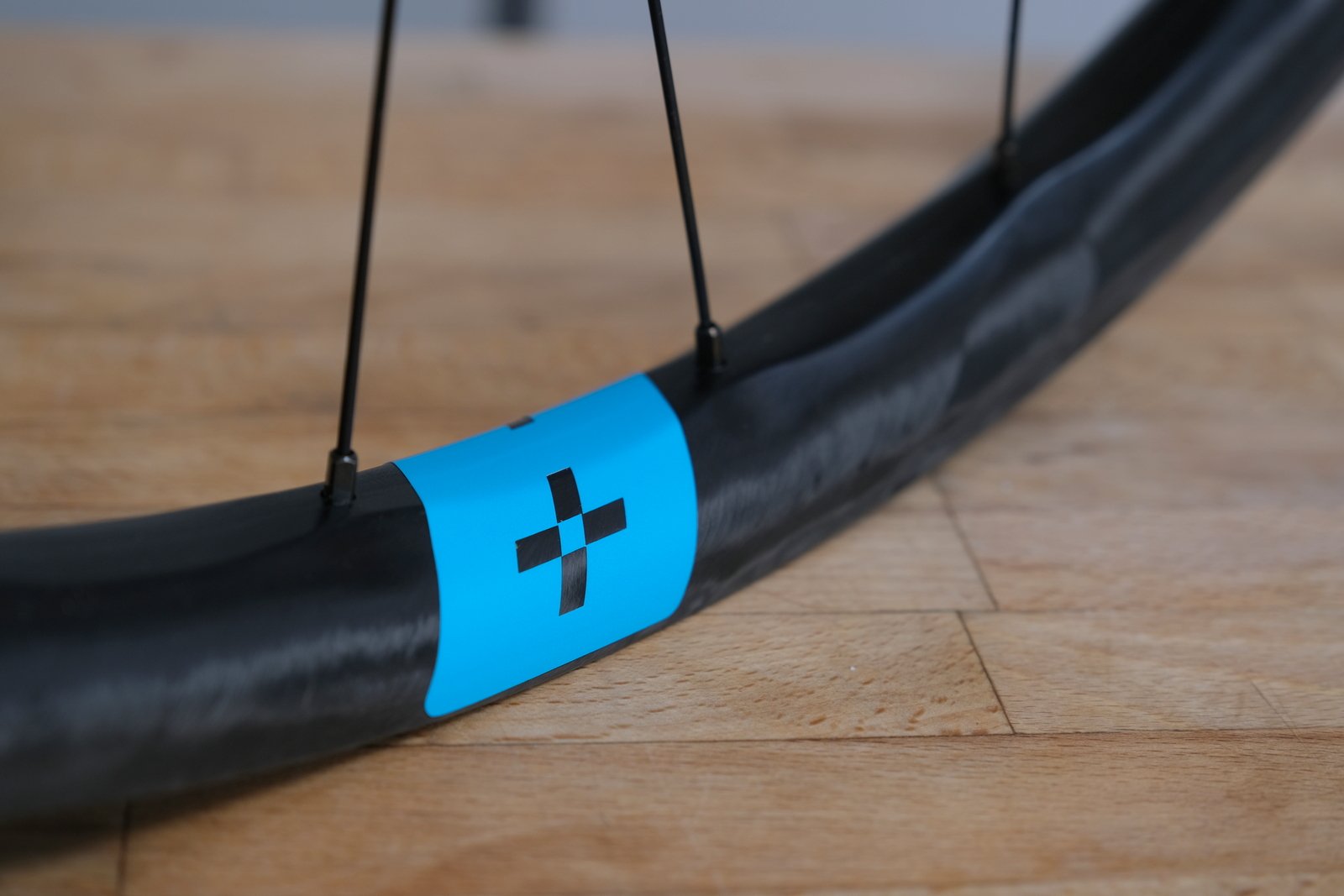
If you couldn't tell, I took these two photos. It's hard to capture the facets on the face of the rim.
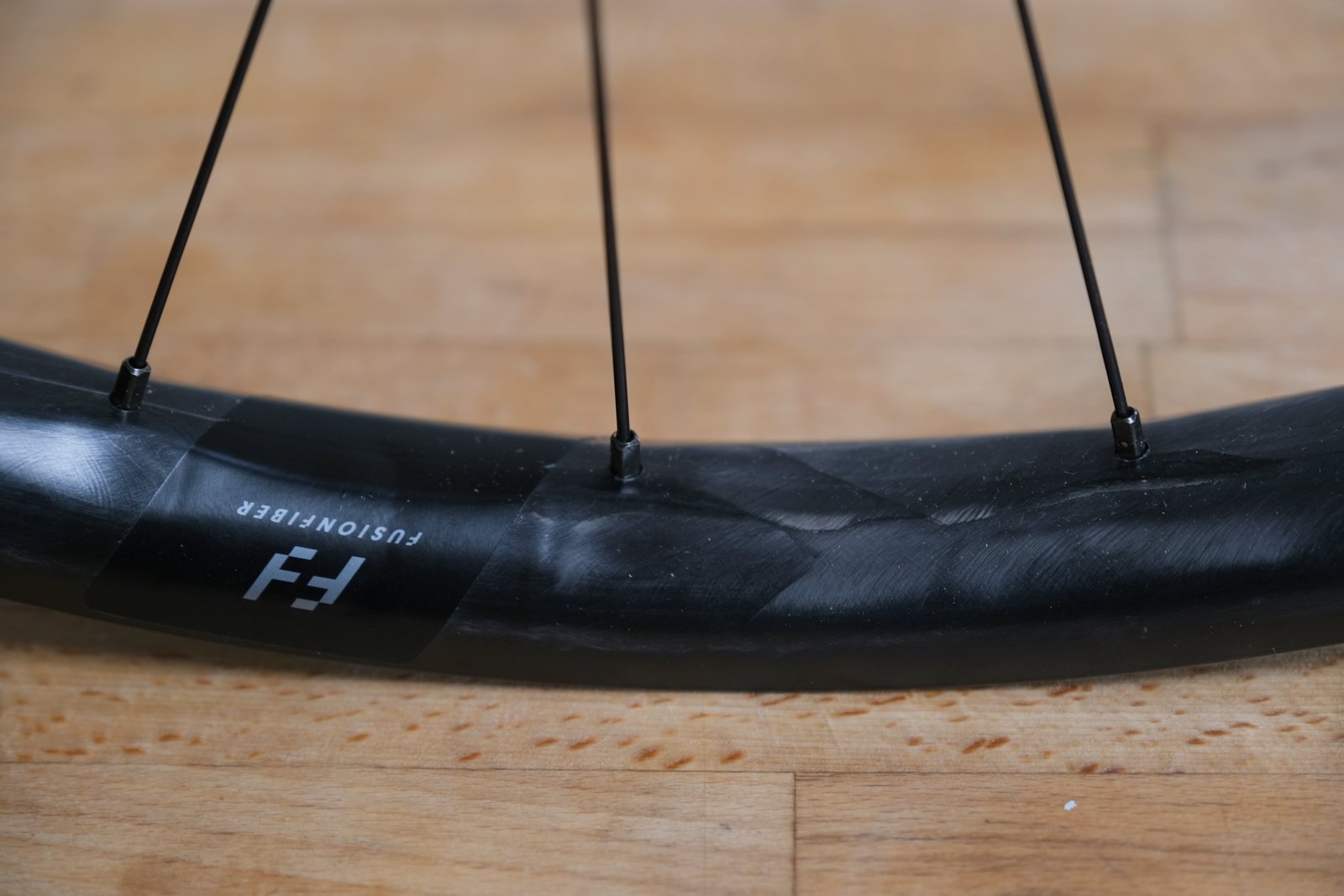
I also realized at this point that I don't have any photos of the wheels mounted on my bike. And it keeps raining. So...maybe for the full review?
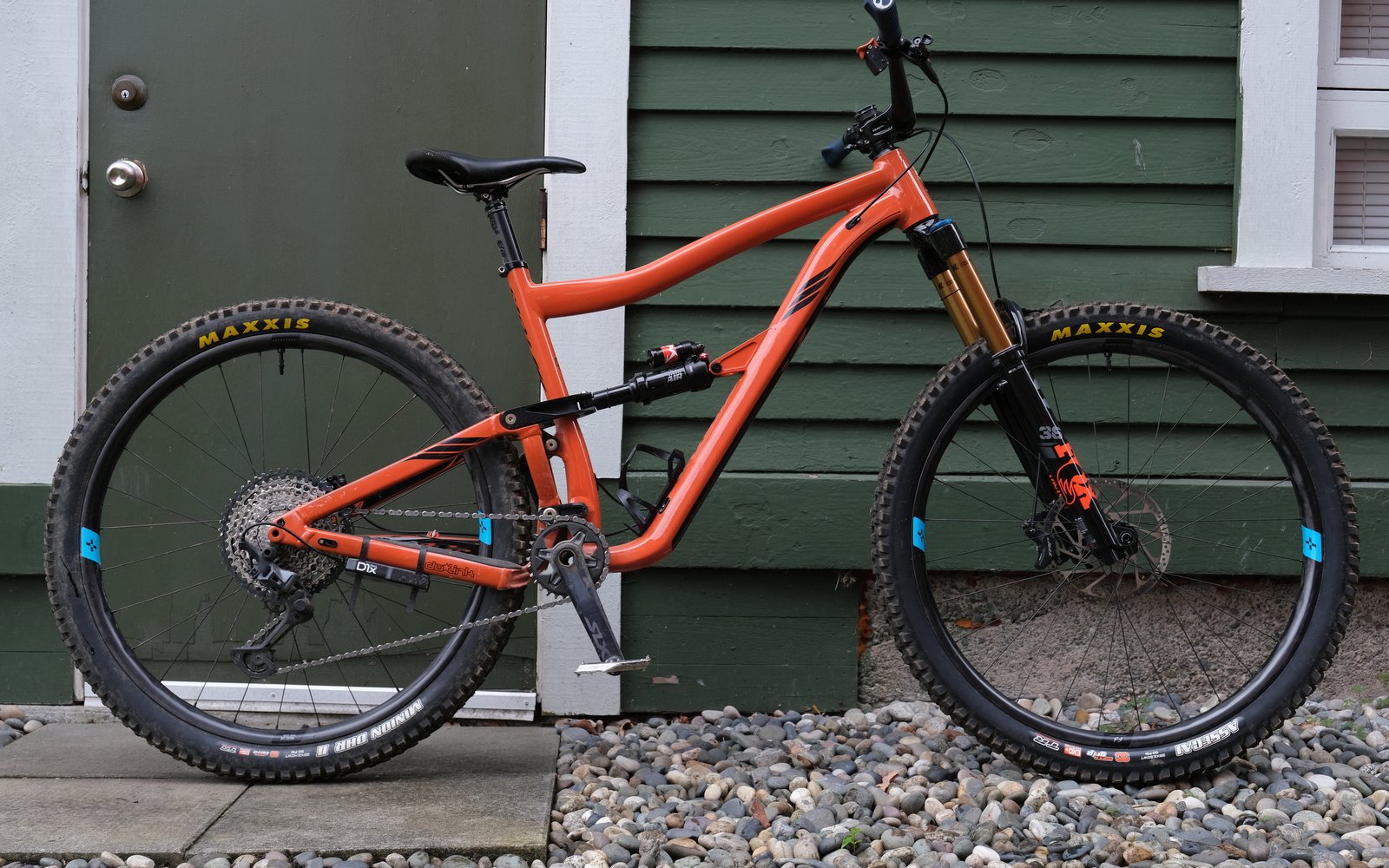
Okay...in between rain storms I got out and took a couple of photos. This Ibis is looking insanely colour coordinated lately.
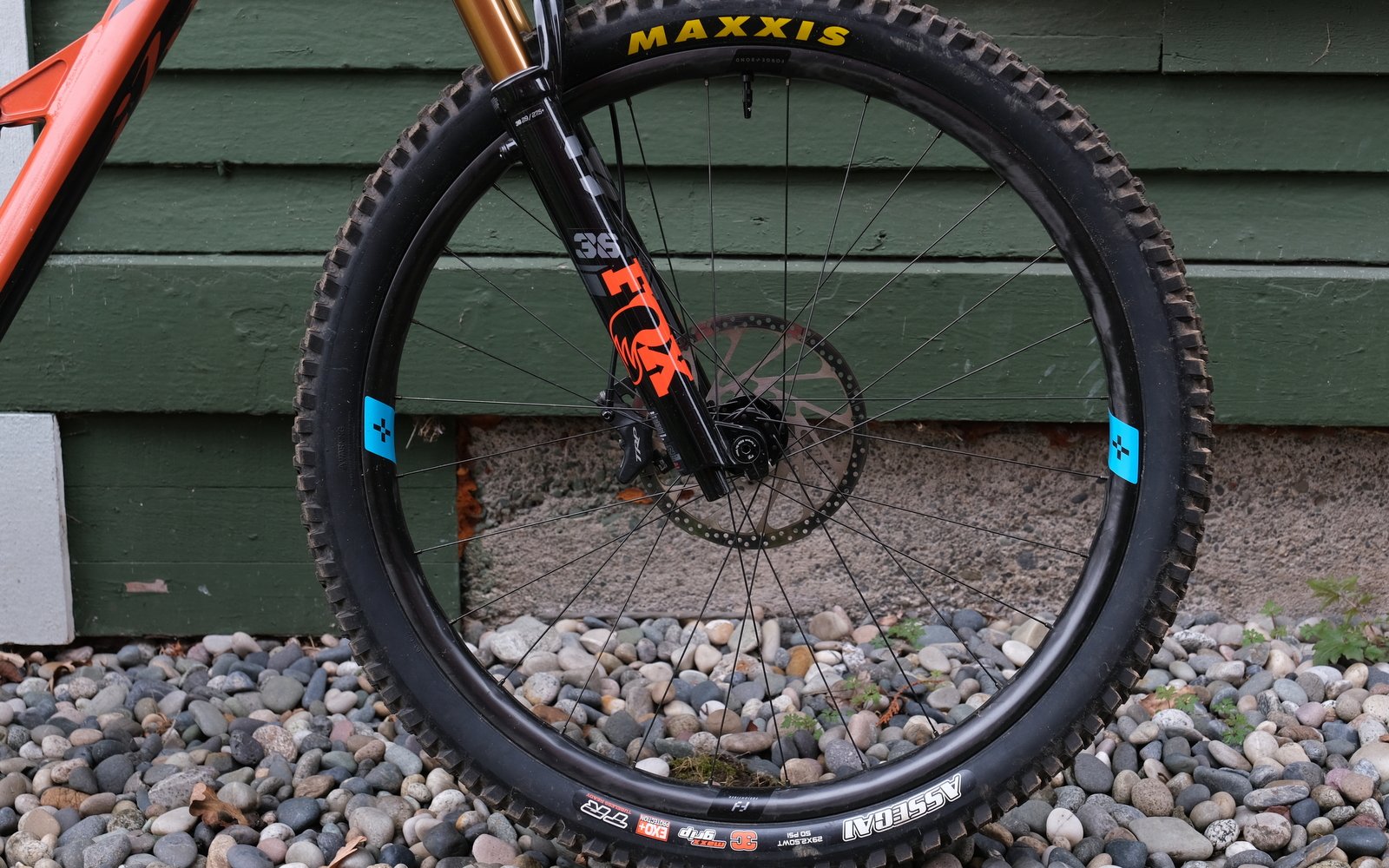
This is what the wheel looks like mounted on a bicycle. This one is the front.
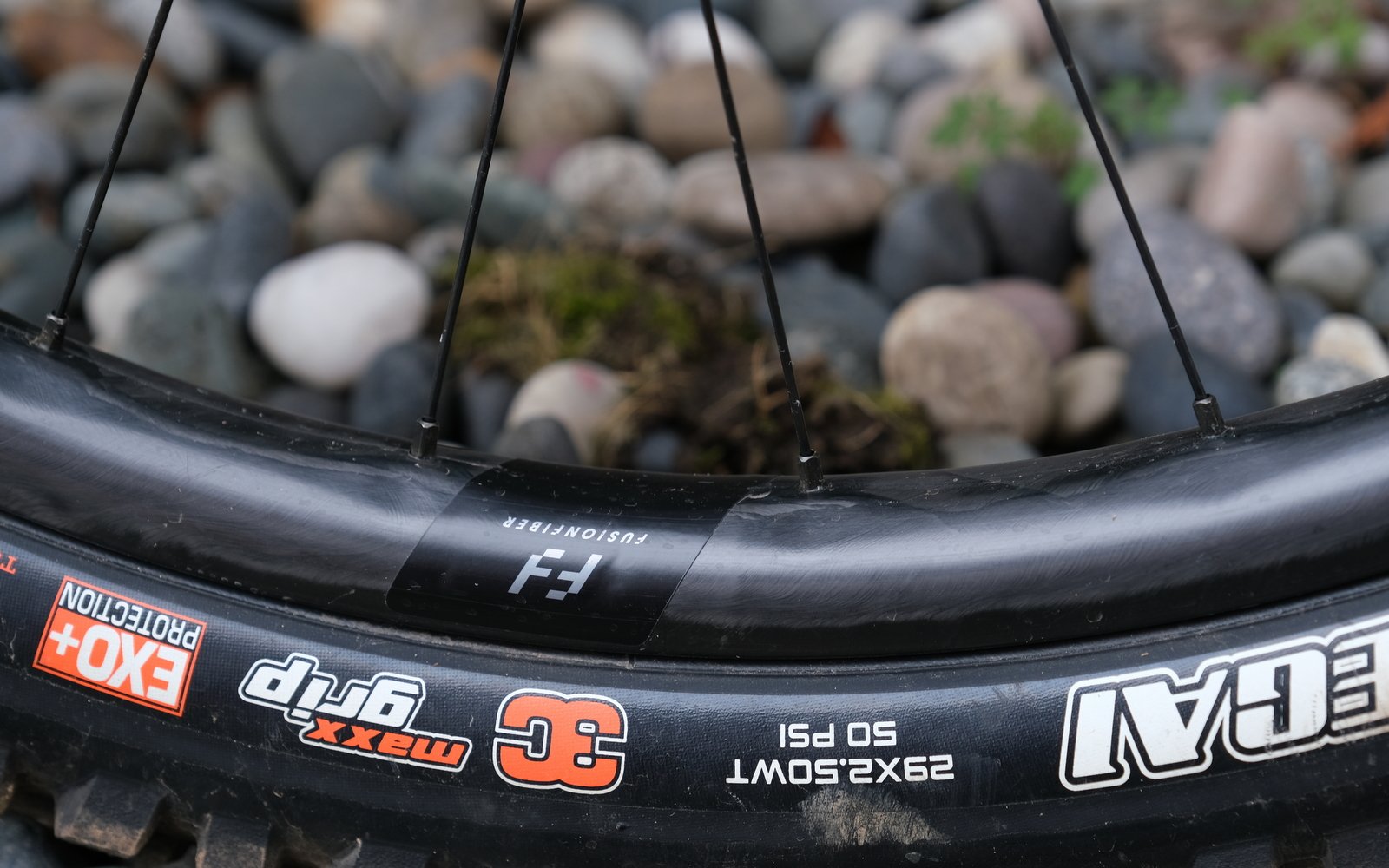
It's hard to see the details of the facets. It's not quite at the same level as the new We Are One, and doesn't change the angle of the nipple.

How often do you get to follow a legendary pro through a corner while a professional photographer documents the process?

In my defense, these were blind trails, ridden once with absolutely no idea where Paris Gore was standing, taking each photo. This one was a bit of a surprise.
Setup
Setup was smooth-ish. The first thing I did after taking the wheels out of the box was put my tensionmeter to them. I don’t necessarily trust the absolute numbers that gauge spits out (it seems to change with temperature, for example) but it does spit out repeatable numbers that allow for comparison of relative spoke tension. The Forge+Bond wheels came with an acceptable degree of difference in spoke tension, but I spent 20-30 minutes tweaking things by a quarter turn here and there, just because. We’ll see how tension looks in a month or so.
Slapping a used Maxxis EXO+ on was a tool-free affair, and it pumped right up with a hand pump, no problem. The front tire…well…let’s just say I got to know just how easy a used Maxxis EXO+ tire slides on and off these rims. The first time around, I blame Forge+Bond. I got the tire mounted but things were not sealing well enough to pop the bead. I pulled out the fire extinguisher 3000, and that was just enough to get the bead popped, but air was flowing everywhere. Feeling lazy, I threw some sealant in there to see what would happen. Bad things happened. The spokes were spittin’ rhymes like A Tribe Called Quest on the Subway. If rhymes were sealant. And not to sidetrack…but now would be a pretty good time to check out the video for Electric Relaxation.
Feeling doubly smart, I decided to do the old tube in the tubeless trick to see if I could force a better seal on the rim strip. I did that, put things together again and it was worse! That one was my fault. I think I put too much pressure in the tube which proceeded to decimate the rim strip at each and every spoke hole (too much pressure forced the rim strip too far into the hole, stretching and tearing the shit out of everything). So, after a quick trip to West Point (shout out to their $7 rim taping deal!) I was good to go.

Paris was hanging from a tree making noises like a monkey for this photo, for fucks sakes! I'm surpised I was capable of keeping it on the trail.
Riding
As mentioned above, Forge+Bond suggested they had built a forgiving wheel that wouldn’t suffer from excessive radial stiffness or harshness. Moving from the stock aluminum wheels on my Ibis I haven’t felt a huge change in how my bike rides. Weights are similar, so I didn’t notice much change in how quickly my bike rolled or pedaled. Ride quality hasn’t felt all that different, either. Most of my riding so far has been on the janky and rough side of things, and I certainly haven’t experienced anything that would contradict Forge+Bond's claims of a forgivable ride. I’ll have to do some back-to-back testing on my go to trails to see if I can pick up on specific differences in ride quality. I suspect that the biggest difference for me is going to be the fact that these wheels don’t look like a dinged up mess a year from now.

Why do we do this to ourselves? Do you really want to see this photo of me riding my bike? What does it prove? You can't even see the wheels!
In Conclusion
A 2600 USD set of mountain bike wheels speaks to a limited portion of our sport. This is a lot of money for something that is available for less from other brands. Heck, you can even get CSS-produced thermoplastic carbon fiber wheels from third parties for less money! Price aside, Forge+Bond offers a compelling narrative and something different. Made-in-North-America-zero-waste-carbon-fiber is a great thing and it makes sense that might command a premium at this point in time. At some point during my day with Forge+Bond another journalist asked/stated “It sounds like you’re selling a manufacturing process more than anything?” Those present were quick to tout the performance advantages of their wheel, but I actually think this statement is fairly close to reality. Turning factory scraps and warranty returns into another product is exciting! I’m super curious to see how this technology develops and where this goes in the future. For now, I’ll continue to ride these wheels and I’ll check back in at some point in the nearish future.







Comments
Ride.DMC
1 year ago
I appreciate the musical references and hyper links to music videos that are always worth a gander.
Reply
Dave Tolnai
1 year ago
Username checks out.
Reply
DanL
1 year ago
So the only way in that these wheels would ever get recycled is if there was a demand for other products (that don't exist past Tyre Levers) that would use them in the process, am I reading that right? Or are there other companies that are going to be utilising this process as well? Or as you write, this is more of a production technique instead of wheels?
Reply
Dave Tolnai
1 year ago
I touched on that a bit, but I don't have a lot of detail. From what I understand is that they do have uses for all of their recycled/reclaimed material, just not in bike parts. They've formed a sister company that's making other stuff (there wasn't a lot of detail given on that) for other industries. The tire lever is just the first thing they've made for bikes and there will probably be more to follow. They're hinting at other products, and suggest that while the short fiber material isn't good for frames or wheels, it is really good for other things.
To me the tire levers are a bit of a red herring. As in "You're going to take multi-thousand dollar wheels and chip them up to make tire levers?" I think there's more to it than that, but time will tell.
Reply
Perry Schebel
1 year ago
yeah. i'm a bit skeptical that any carbon "recycling" initiatives are much more than marketing spiels intended to make us feel a little less bad about high $$ trinket expenditures. i'm sure the costs & energy required to reclaim / mulch / reform these things are high (perhaps higher than manufacturing with virgin materials), and the materials are degraded in the process so it's a one shot deal. for people that regularly smash alu rims, i can see the net benefit of burly carbon hoops, but i'm dubious that carbon recyclability is a tangible value adder (monetarily or environmentally).
Reply
Dave Tolnai
1 year ago
I guess you could say that about any recycled material? They all require some amount of energy put back in to turn it into something else, so why is this different? The process of building things out of the recycled material actually sounded fairly simple. Chip it up (I'm sure there's some complexity to get the right properties out of the material), deposit the material in a mold, apply heat and pressure and out the back comes your part.
I didn't get a sense that this was something they were doing for the story. They seemed genuine about what they were building using this recycled material. And funny you mention it, they said it's not a one shot deal. It can be recycled again and again. Not sure at what point your fiber length gets too short to be of value.
I'll dig into this a bit in the final review and find out a bit more about what they are making using this stuff. Maybe they'll have another bike part by that point?
Reply
Perry Schebel
1 year ago
i'm thinking in relation to alu, which is "infinitely" recyclable, with recovery streams that are readily accessible. product that requires shipment to one location for specialized recovery is going to see a miniscule return rate.
but yeah, recyclability may not be THE primary talking point for the promotion of this product, but given the price premium, buyers will be looking for something tangible to justify the spread. though i suppose for US made product, it doesn't look that bad; WR1 is just really good value (esp. given the current exchange rate).
Reply
Dave Tolnai
1 year ago
Well it's all a bit relative, isn't it? Aluminum still takes energy to recycle, and it also downcycles itself with each iteration. High grade bike frames aren't recycled back into high grade bike frames.
I don't disagree with you on the price premium. I'm not suggesting that justifies the increased price, but I do find the possibilities of this material to be interesting.
Vik Banerjee
1 year ago
"Is recycling aluminium easy?
Aluminium is the most cost-effective material to recycle, using around only 5% of the energy and emissions needed to make it from the raw material bauxite. In addition, all the scraps left over from the aluminium production process can be melted down and used again and again."
For common MTB frame/component materials it's hard to beat aluminum if your concern is recycling.
DanL
1 year ago
Thanks Dave, yeah, I hope this can go further and that they achieve the scaling up that this process needs to survive. Maybe the tyre levers were the first things that they could get out?
Fix Bindings have had a good recycle/ end-of-life system going but granted, they cannot recycle the entire of the binding.
Reply
Deniz Merdano
1 year ago
This gives me all the feels.
> > The first thing I did after taking the wheels out of the box was put my tensionmeter to them. I don’t necessarily trust the absolute numbers that gauge spits out (it seems to change with temperature, for example) but it does spit out repeatable numbers that allow for comparison of relative spoke tension.
Reply
Dave Tolnai
1 year ago
I'm saving those charts for the full review.
Reply
Alex D
1 year ago
It feels to me like 'recycling' as a negative for carbon emerged from nowhere. The global demand for carbon fiber is around 80,000 tons, of which carbon bike rims are about 50 tons. Even accounting for manufacturing waste, these are just trivial numbers. (For context, global demand for aluminum is around 65 million tons.) Putting aside the merits (or not) of thermoplastic, I don't accept the premise that carbon fiber recycling is a problem that needs to be solved here.
Reply
Cooper Quinn
1 year ago
This is... a pretty important point. But I think you're off on the scale of the global carbon fiber market by several orders of magnitude.
Where are you getting the numbers on carbon bike rims, I'm quite curious there.
Reply
Alex D
1 year ago
> The global carbon fiber market is expected to reach 123,710 million tons by the end of this year
This article has some confusion over units. MT is metric tons, not million tons. The number given is 500 times the global production of iron ore.
For wheels, I actually looked at the wrong article (one for carbon car wheels), but we can probably make some educated guesses from other figures.
https://www.grandviewresearch.com/industry-analysis/bicycle-market
$65B is the market for all bicycles globally, about half of which are road and mountain bikes. Of those, I'd guess (generously) that 5% or less come with carbon wheels, so $1.5B in bicycles. If we assume $4000 for the average transaction price, that's 375K bicycles, or 750K wheels. The average rim weight is probably 450g. Let's assume 25% waste. We arrive at 420 tons of carbon fiber prepreg. Aftermarket wheel sales might add another 10%.
Which means I was probably undershooting by a factor of 10, but it doesn't matter. I could be off by a factor of 100 without changing the point. 450 tons of carbon fiber would cover a single football field to a depth of about four feet. Distributed across all the landfills in just the USA, it'd be 0.0014mm deep.
Reply
Cooper Quinn
1 year ago
To be clear- I agree with you. What your bike and rims are made out of is a functionally irrelevant contributor to your personal carbon footprint. And I've belabored this point repeatedly, haha.
https://nsmb.com/articles/trek-top-fuel-review/
https://nsmb.com/articles/pnw-components-range-gen-3-bar-and-stem/
(and Mt is... actually the abbreviation for megatons, not metric tonnes (mt). But we don't need to split hairs here, I follow your point).
Reply
Alex D
1 year ago
Dave's article on Trek's sustainability report and your Trek review really put this greenwashing into perspective. Driving twenty miles to a trail a few times appears to outstrip the carbon footprint difference between CF and aluminum wheels. If anyone really cares (do they?), better to buy the latter and donate the remaining $2000 to a tree farm.
Reply
Dave Tolnai
1 year ago
I hope that wasn't the only conclusion that you took away from those articles! A couple of points.
1) I don't look at anything that Trek is doing as "greenwashing". You could say that it's a drop in the bucket, which is fair. I think that they're asking the right questions though and it's a good step in the right direction. Measuring is always a step in the right direction. As well, everybody should be questiong the amount of packaging that things come in.
2) The whole "drop in a bucket" argument is dangerous, and you can see it trotted out by climate change deniers all the time. "Ya, sure, it's a problem. But what can Canada do if China isn't doing more?" Or somesuch.
Yes, in the grand scheme of things, the material that Forge+Bond/CSS will keep out of landfills is miniscule, but it starts somewhere. So, if you were to ask me the question of which I would prefer, a recyclable or a non-recyclable option, all else being equal I'll take the recyclable option. Does it justify paying $800 more? Well, that's an individual question that most people probably won't answer "yes" to. But maybe next year they come out with a USD1800 wheelset and that does become a real question to struggle with. I mean, for a normal person. It would put my overly analytical brain into a coma if I shelled out 1800USD for a set of wheels.
I think I've said this before, but if you want to point your finger at the true criminals of climate change, garbage and waste...well...start with things like the Oil & Gas industry...the construction industry...the transportation industry...etc. But, of course, that is us. Those things don't exist in a vacuum and it's things like expensive carbon fiber bicycles that put us in the top tier of per capita users. So we can't ignore that. All of these drops add up to something bigger. It seems to me that we should hold our frivolous, unecessary purchases to a higher standard. I'm not saying that this is the answer! I just don't think what they're proposing here is a bad thing.
Alex D
1 year ago
Dave, this is Google's return for greenwashing:
"... making an unsubstantiated claim to deceive consumers into believing that a company's products are environmentally friendly or have a greater positive environmental impact than they actually do."
That's every claim on F&B's site. Is this actually a better manufacturing process for environment? Who knows. Absent data, there's no reason to assume it is. The promise of recycling is equally suspect. What's the carbon footprint for shipping a wheel back and breaking it down ad hoc? Less than new thermoplastic? Again, who knows. I doubt even they do; if they did, they'd be crowing about it.
Here's what I do know: this manufacturing approach is good for F&B. They're asking above-carbon prices for automated production with cheaper inputs, for a product that doesn't appear to have any advantages on the merits.
On Trek: that sustainability report listed indisputably positive results. Packaging reduced, shipping optimized, etc. And yet, you have to go 3/4 down the home page before you even see a blurb about sustainability. That's anti-greenwashing to me; they're doing it because they want to (we can tell because the initiatives are measurable), not because the brand's value proposition depends on it.
Peter Appleton
1 year ago
why vs We are one?
Reply
mk.ultra
1 year ago
For a weird flex
Reply
Perry Schebel
1 year ago
a $1500 premium to be able to turn your rims into tire levers is a small price to pay.
Reply
Dave Tolnai
1 year ago
Indeed, this is the question. And I wouldn't take anything written above as "you should spend more money on these over We Are One or other options". For me, the most interesting thing about this is the process, not necessarily the product. That being said, you could look at this as being a similar, yet totally different product than a We Are One. Yes, they share carbon fibers, but what holds those fibers together is totally different, requiring different methods of fabrication and resulting in a product with different properties. I guess the question is does that result in a better wheel? I don't have an answer to that yet. I mean, I might not ever. But it certainly is interesting. Thinking about a carbon fiber product as something that you gradually form and piece together could certainly take us in different directions than where we are now. And it seems like people are poo-pooing the recycling thing a little bit...but again, how many people are taking factory scraps, rejects and warrantied parts and turning that into another usable product right in the building? Not very many, I would say. Although...there's sketchy things that happen in breweries witih leftover tanks of beer...but perhaps that's another story.
Actually...that's a fun story. There's a fairly famous mass market beer, popular on the island, named after a well known property of the Irish. Legend has it that it got that name because, well, what you got was based on your luck as to which particular tank dregs you mixed together for that particular brew.
So, worst case, we have another brand in the market, doing things a bit differently. Even if you're not interested in buying their wheels, that doesn't feel like all that bad a thing. And I just rode the skytrain today beside a lady with a Louis Vuitton purse, backpack and baseball cap, so who knows what people are going to spend money on these days?
Reply
Please log in to leave a comment.